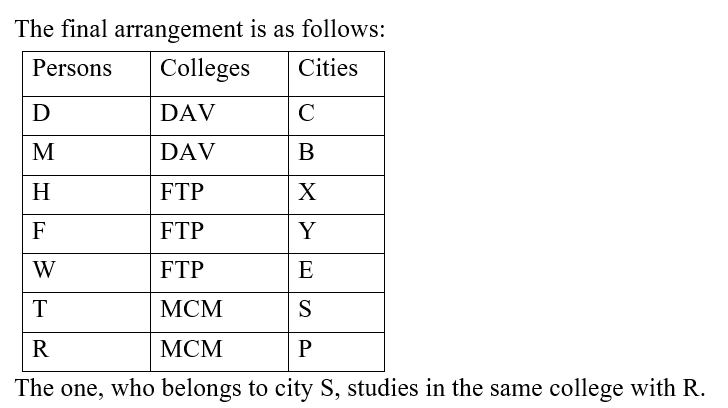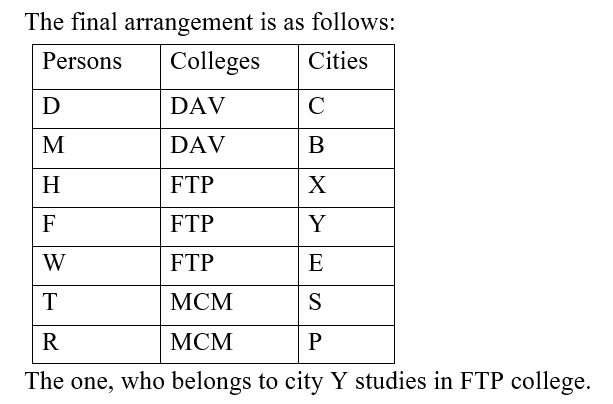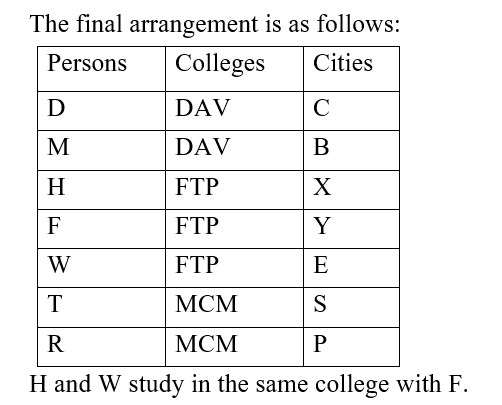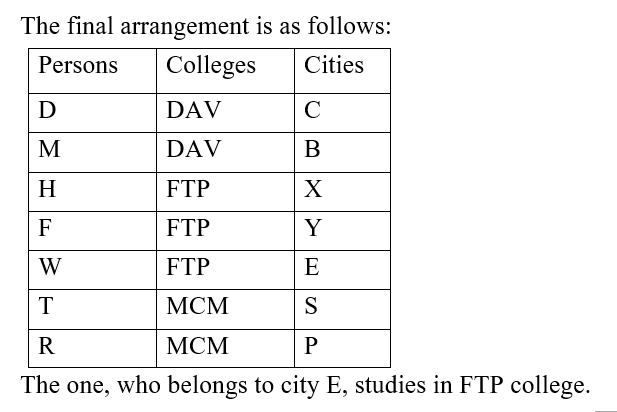Question 1:
Directions: Answer the questions based on the information given below.
निर्देश: नीचे दी गई जानकारी के आधार पर प्रश्नों के उत्तर दें।
Seven persons D, F, H, M, R, T and W are studying in three different colleges i.e., MCM, DAV and FTP with at least two in each college. Each one of them belongs to seven different cities i.e., B, C, E, P, S, X and Y, but not necessarily in the same order.
D, who belongs to city C, studies in DAV with only M. R does not belong to city S. H, who does not study in MCM, belongs to city X. F studies in FTP but does not belong to city B. Those who belong to city P and S study in the same college. W belongs to city E but W does not study in MCM. M does not belong to city Y.
7 व्यक्ति D, F, H, M, R, T और W तीन अलग-अलग कॉलेजों अर्थात MCM, DAV और FTP में पढ़ते हैं जहाँ प्रत्येक कॉलेज में कम से कम दो व्यक्ति पढ़ते हैं। इनमें से प्रत्येक सात अलग-अलग शहरों अर्थात B, C, E, P, S, X और Y के रहने वाले हैं, लेकिन जरूरी नहीं कि इसी क्रम में हो।
D, जो शहर C का रहने वाला है, केवल M के साथ DAV में पढ़ता है। R, शहर S का रहने वाला नहीं है। H, जो MCM में नहीं पढ़ता है, शहर X का रहने वाला है। F, FTP में पढ़ता है लेकिन शहर B का रहने वाला नहीं है।वह व्यक्ति, जो शहर P और S के रहने वाले हैं, एक ही कॉलेज में पढ़ते हैं। W शहर E का रहने वाला है लेकिन W, MCM में नहीं पढ़ता है। M शहर Y का रहने वाला नहीं है।
Who among the following belongs to city B?
निम्नलिखित में से कौन शहर B से संबंधित है?
Question 2:
Directions: Answer the questions based on the information given below.
निर्देश: नीचे दी गई जानकारी के आधार पर प्रश्नों के उत्तर दें।
Seven persons D, F, H, M, R, T and W are studying in three different colleges i.e., MCM, DAV and FTP with at least two in each college. Each one of them belongs to seven different cities i.e., B, C, E, P, S, X and Y, but not necessarily in the same order.
D, who belongs to city C, studies in DAV with only M. R does not belong to city S. H, who does not study in MCM, belongs to city X. F studies in FTP but does not belong to city B. Those who belong to city P and S study in the same college. W belongs to city E but W does not study in MCM. M does not belong to city Y.
7 व्यक्ति D, F, H, M, R, T और W तीन अलग-अलग कॉलेजों अर्थात MCM, DAV और FTP में पढ़ते हैं जहाँ प्रत्येक कॉलेज में कम से कम दो व्यक्ति पढ़ते हैं। इनमें से प्रत्येक सात अलग-अलग शहरों अर्थात B, C, E, P, S, X और Y के रहने वाले हैं, लेकिन जरूरी नहीं कि इसी क्रम में हो।
D, जो शहर C का रहने वाला है, केवल M के साथ DAV में पढ़ता है। R, शहर S का रहने वाला नहीं है। H, जो MCM में नहीं पढ़ता है, शहर X का रहने वाला है। F, FTP में पढ़ता है लेकिन शहर B का रहने वाला नहीं है।वह व्यक्ति, जो शहर P और S के रहने वाले हैं, एक ही कॉलेज में पढ़ते हैं। W शहर E का रहने वाला है लेकिन W, MCM में नहीं पढ़ता है। M शहर Y का रहने वाला नहीं है।
Who among the following studies in the same college with R?
निम्नलिखित में से कौन R के साथ एक ही कॉलेज में पढ़ता है?
Question 3:
Directions: Answer the questions based on the information given below.
निर्देश: नीचे दी गई जानकारी के आधार पर प्रश्नों के उत्तर दें।
Seven persons D, F, H, M, R, T and W are studying in three different colleges i.e., MCM, DAV and FTP with at least two in each college. Each one of them belongs to seven different cities i.e., B, C, E, P, S, X and Y, but not necessarily in the same order.
D, who belongs to city C, studies in DAV with only M. R does not belong to city S. H, who does not study in MCM, belongs to city X. F studies in FTP but does not belong to city B. Those who belong to city P and S study in the same college. W belongs to city E but W does not study in MCM. M does not belong to city Y.
7 व्यक्ति D, F, H, M, R, T और W तीन अलग-अलग कॉलेजों अर्थात MCM, DAV और FTP में पढ़ते हैं जहाँ प्रत्येक कॉलेज में कम से कम दो व्यक्ति पढ़ते हैं। इनमें से प्रत्येक सात अलग-अलग शहरों अर्थात B, C, E, P, S, X और Y के रहने वाले हैं, लेकिन जरूरी नहीं कि इसी क्रम में हो।
D, जो शहर C का रहने वाला है, केवल M के साथ DAV में पढ़ता है। R, शहर S का रहने वाला नहीं है। H, जो MCM में नहीं पढ़ता है, शहर X का रहने वाला है। F, FTP में पढ़ता है लेकिन शहर B का रहने वाला नहीं है।वह व्यक्ति, जो शहर P और S के रहने वाले हैं, एक ही कॉलेज में पढ़ते हैं। W शहर E का रहने वाला है लेकिन W, MCM में नहीं पढ़ता है। M शहर Y का रहने वाला नहीं है।
Who among the following studies in FTP college?
निम्नलिखित में से कौन FTP कॉलेज में पढ़ता है?
Question 4:
Directions: Answer the questions based on the information given below.
निर्देश: नीचे दी गई जानकारी के आधार पर प्रश्नों के उत्तर दें।
Seven persons D, F, H, M, R, T and W are studying in three different colleges i.e., MCM, DAV and FTP with at least two in each college. Each one of them belongs to seven different cities i.e., B, C, E, P, S, X and Y, but not necessarily in the same order.
D, who belongs to city C, studies in DAV with only M. R does not belong to city S. H, who does not study in MCM, belongs to city X. F studies in FTP but does not belong to city B. Those who belong to city P and S study in the same college. W belongs to city E but W does not study in MCM. M does not belong to city Y.
7 व्यक्ति D, F, H, M, R, T और W तीन अलग-अलग कॉलेजों अर्थात MCM, DAV और FTP में पढ़ते हैं जहाँ प्रत्येक कॉलेज में कम से कम दो व्यक्ति पढ़ते हैं। इनमें से प्रत्येक सात अलग-अलग शहरों अर्थात B, C, E, P, S, X और Y के रहने वाले हैं, लेकिन जरूरी नहीं कि इसी क्रम में हो।
D, जो शहर C का रहने वाला है, केवल M के साथ DAV में पढ़ता है। R, शहर S का रहने वाला नहीं है। H, जो MCM में नहीं पढ़ता है, शहर X का रहने वाला है। F, FTP में पढ़ता है लेकिन शहर B का रहने वाला नहीं है।वह व्यक्ति, जो शहर P और S के रहने वाले हैं, एक ही कॉलेज में पढ़ते हैं। W शहर E का रहने वाला है लेकिन W, MCM में नहीं पढ़ता है। M शहर Y का रहने वाला नहीं है।
Who among the following studies with F in the same college?
निम्नलिखित में से कौन F के साथ समान कॉलेज में पढ़ाई करता है?
Question 5:
Directions: Answer the questions based on the information given below.
निर्देश: नीचे दी गई जानकारी के आधार पर प्रश्नों के उत्तर दें।
Seven persons D, F, H, M, R, T and W are studying in three different colleges i.e., MCM, DAV and FTP with at least two in each college. Each one of them belongs to seven different cities i.e., B, C, E, P, S, X and Y, but not necessarily in the same order.
D, who belongs to city C, studies in DAV with only M. R does not belong to city S. H, who does not study in MCM, belongs to city X. F studies in FTP but does not belong to city B. Those who belong to city P and S study in the same college. W belongs to city E but W does not study in MCM. M does not belong to city Y.
7 व्यक्ति D, F, H, M, R, T और W तीन अलग-अलग कॉलेजों अर्थात MCM, DAV और FTP में पढ़ते हैं जहाँ प्रत्येक कॉलेज में कम से कम दो व्यक्ति पढ़ते हैं। इनमें से प्रत्येक सात अलग-अलग शहरों अर्थात B, C, E, P, S, X और Y के रहने वाले हैं, लेकिन जरूरी नहीं कि इसी क्रम में हो।
D, जो शहर C का रहने वाला है, केवल M के साथ DAV में पढ़ता है। R, शहर S का रहने वाला नहीं है। H, जो MCM में नहीं पढ़ता है, शहर X का रहने वाला है। F, FTP में पढ़ता है लेकिन शहर B का रहने वाला नहीं है।वह व्यक्ति, जो शहर P और S के रहने वाले हैं, एक ही कॉलेज में पढ़ते हैं। W शहर E का रहने वाला है लेकिन W, MCM में नहीं पढ़ता है। M शहर Y का रहने वाला नहीं है।
Which of the following statements is true?
निम्नलिखित में से कौन-सा कथन सत्य हैं?
Question 6:
Directions: Answer the questions based on the information given below.
निर्देश: नीचे दी गई जानकारी के आधार पर प्रश्नों के उत्तर दें।
Twelve persons, A, B, C, D, E, F, G, H, I, J, K and L are sitting in a row. Each of them is facing north. No two persons with names starting with consecutive alphabets sit adjacent to each other.
C is sitting 4th to the left of A. H is sitting adjacent to C. One person is sitting between B and H. One person is sitting between C and G. Three persons are sitting between G and I. One person is sitting between I and K. J is sitting 3rd to the left of L. Number of persons sitting between F and D is not one.
बारह व्यक्ति, A, B, C, D, E, F, G, H, I, J, K और L एक पंक्ति में बैठे हैं। इनमे से प्रत्येक का मुख उत्तर की ओर है। वैसे कोई भी दो व्यक्ति एक दूसरे के आसन्न नहीं बैठे हैं जिनके नाम लगातार अक्षरों से शुरू होते हैं|
C, A के बाएं से चौथे स्थान पर बैठा है। H, C के आसन्न बैठा है। B और H के बीच एक व्यक्ति बैठा है। C और G के बीच एक व्यक्ति बैठा है। G और I के बीच तीन व्यक्ति बैठे हैं। I और K के बीच एक व्यक्ति बैठा है। J, L के बाएं से तीसरे स्थान पर बैठा है। F और D के बीच बैठे व्यक्तियों की संख्या एक नहीं है।
How many persons are sitting to the left of L?
कितने व्यक्ति L के बाएं बैठे हैं?
Question 7:
Directions: Answer the questions based on the information given below.
निर्देश: नीचे दी गई जानकारी के आधार पर प्रश्नों के उत्तर दें।
Twelve persons, A, B, C, D, E, F, G, H, I, J, K and L are sitting in a row. Each of them is facing north. No two persons with names starting with consecutive alphabets sit adjacent to each other.
C is sitting 4th to the left of A. H is sitting adjacent to C. One person is sitting between B and H. One person is sitting between C and G. Three persons are sitting between G and I. One person is sitting between I and K. J is sitting 3rd to the left of L. Number of persons sitting between F and D is not one.
बारह व्यक्ति, A, B, C, D, E, F, G, H, I, J, K और L एक पंक्ति में बैठे हैं। इनमे से प्रत्येक का मुख उत्तर की ओर है। वैसे कोई भी दो व्यक्ति एक दूसरे के आसन्न नहीं बैठे हैं जिनके नाम लगातार अक्षरों से शुरू होते हैं|
C, A के बाएं से चौथे स्थान पर बैठा है। H, C के आसन्न बैठा है। B और H के बीच एक व्यक्ति बैठा है। C और G के बीच एक व्यक्ति बैठा है। G और I के बीच तीन व्यक्ति बैठे हैं। I और K के बीच एक व्यक्ति बैठा है। J, L के बाएं से तीसरे स्थान पर बैठा है। F और D के बीच बैठे व्यक्तियों की संख्या एक नहीं है।
How many persons are sitting between F and C?
कितने व्यक्ति F और C के बीच बैठे हैं?
Question 8:
Directions: Answer the questions based on the information given below.
निर्देश: नीचे दी गई जानकारी के आधार पर प्रश्नों के उत्तर दें।
Twelve persons, A, B, C, D, E, F, G, H, I, J, K and L are sitting in a row. Each of them is facing north. No two persons with names starting with consecutive alphabets sit adjacent to each other.
C is sitting 4th to the left of A. H is sitting adjacent to C. One person is sitting between B and H. One person is sitting between C and G. Three persons are sitting between G and I. One person is sitting between I and K. J is sitting 3rd to the left of L. Number of persons sitting between F and D is not one.
बारह व्यक्ति, A, B, C, D, E, F, G, H, I, J, K और L एक पंक्ति में बैठे हैं। इनमे से प्रत्येक का मुख उत्तर की ओर है। वैसे कोई भी दो व्यक्ति एक दूसरे के आसन्न नहीं बैठे हैं जिनके नाम लगातार अक्षरों से शुरू होते हैं|
C, A के बाएं से चौथे स्थान पर बैठा है। H, C के आसन्न बैठा है। B और H के बीच एक व्यक्ति बैठा है। C और G के बीच एक व्यक्ति बैठा है। G और I के बीच तीन व्यक्ति बैठे हैं। I और K के बीच एक व्यक्ति बैठा है। J, L के बाएं से तीसरे स्थान पर बैठा है। F और D के बीच बैठे व्यक्तियों की संख्या एक नहीं है।
____ is sitting 3rd from the right end.
____ दाएं छोर से तीसरे स्थान पर बैठा है।
Question 9:
Directions: Answer the questions based on the information given below.
निर्देश: नीचे दी गई जानकारी के आधार पर प्रश्नों के उत्तर दें।
Twelve persons, A, B, C, D, E, F, G, H, I, J, K and L are sitting in a row. Each of them is facing north. No two persons with names starting with consecutive alphabets sit adjacent to each other.
C is sitting 4th to the left of A. H is sitting adjacent to C. One person is sitting between B and H. One person is sitting between C and G. Three persons are sitting between G and I. One person is sitting between I and K. J is sitting 3rd to the left of L. Number of persons sitting between F and D is not one.
बारह व्यक्ति, A, B, C, D, E, F, G, H, I, J, K और L एक पंक्ति में बैठे हैं। इनमे से प्रत्येक का मुख उत्तर की ओर है। वैसे कोई भी दो व्यक्ति एक दूसरे के आसन्न नहीं बैठे हैं जिनके नाम लगातार अक्षरों से शुरू होते हैं|
C, A के बाएं से चौथे स्थान पर बैठा है। H, C के आसन्न बैठा है। B और H के बीच एक व्यक्ति बैठा है। C और G के बीच एक व्यक्ति बैठा है। G और I के बीच तीन व्यक्ति बैठे हैं। I और K के बीच एक व्यक्ति बैठा है। J, L के बाएं से तीसरे स्थान पर बैठा है। F और D के बीच बैठे व्यक्तियों की संख्या एक नहीं है।
__ is sitting 3rd to the left of D.
___D के बाएं से तीसरे स्थान पर बैठा है।
Question 10:
Directions: Answer the questions based on the information given below.
निर्देश: नीचे दी गई जानकारी के आधार पर प्रश्नों के उत्तर दें।
Twelve persons, A, B, C, D, E, F, G, H, I, J, K and L are sitting in a row. Each of them is facing north. No two persons with names starting with consecutive alphabets sit adjacent to each other.
C is sitting 4th to the left of A. H is sitting adjacent to C. One person is sitting between B and H. One person is sitting between C and G. Three persons are sitting between G and I. One person is sitting between I and K. J is sitting 3rd to the left of L. Number of persons sitting between F and D is not one.
बारह व्यक्ति, A, B, C, D, E, F, G, H, I, J, K और L एक पंक्ति में बैठे हैं। इनमे से प्रत्येक का मुख उत्तर की ओर है। वैसे कोई भी दो व्यक्ति एक दूसरे के आसन्न नहीं बैठे हैं जिनके नाम लगातार अक्षरों से शुरू होते हैं|
C, A के बाएं से चौथे स्थान पर बैठा है। H, C के आसन्न बैठा है। B और H के बीच एक व्यक्ति बैठा है। C और G के बीच एक व्यक्ति बैठा है। G और I के बीच तीन व्यक्ति बैठे हैं। I और K के बीच एक व्यक्ति बैठा है। J, L के बाएं से तीसरे स्थान पर बैठा है। F और D के बीच बैठे व्यक्तियों की संख्या एक नहीं है।
How many persons are sitting to the right of H?
H के दाएं ओर कितने व्यक्ति बैठे हैं?










